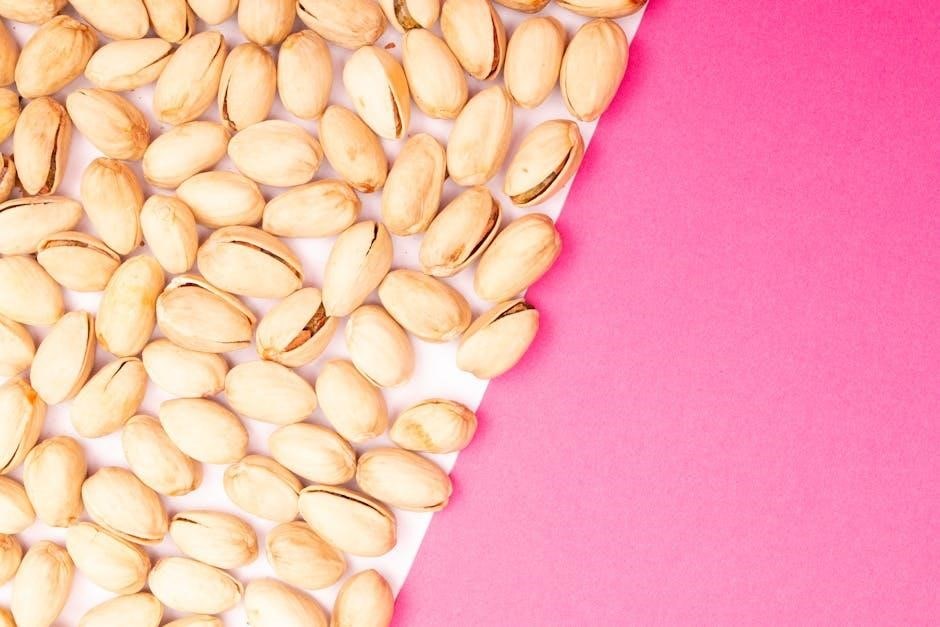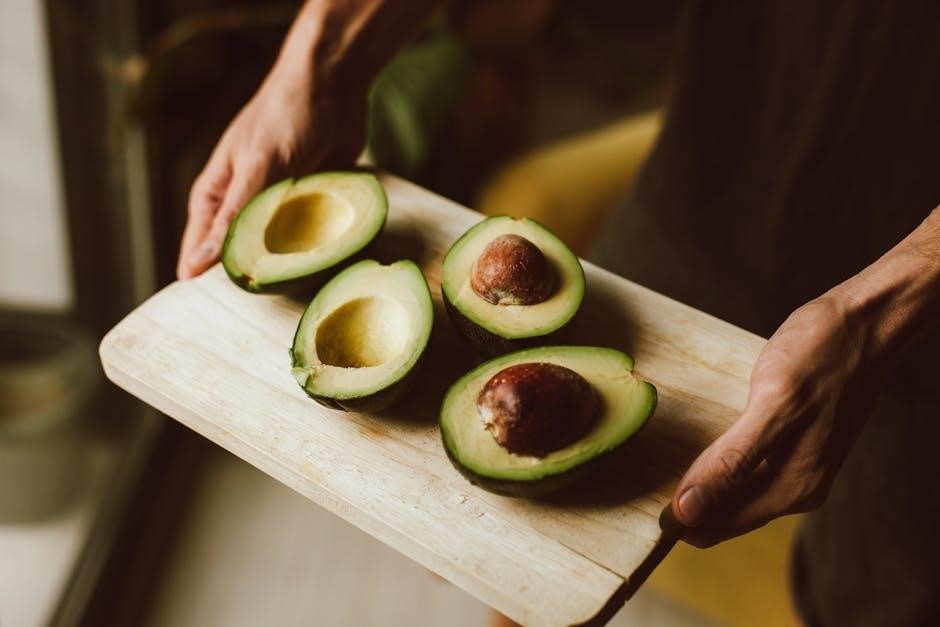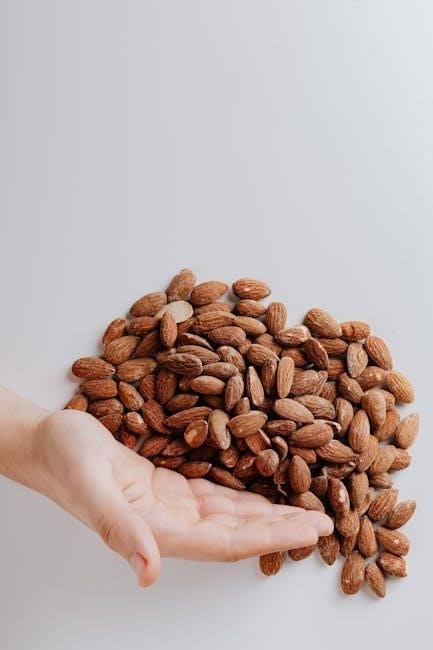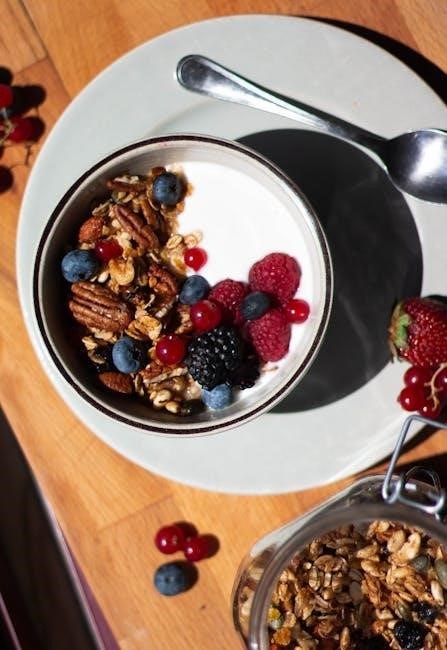A low-fat diet focuses on reducing fat intake to promote health and weight management. It emphasizes whole foods, lean proteins, and healthy fats to prevent chronic diseases.
1.1 What is a Low-Fat Diet?
A low-fat diet is a dietary approach that limits fat intake, particularly saturated and trans fats, to promote health and weight management. It emphasizes whole, nutrient-dense foods like fruits, vegetables, whole grains, and lean proteins. The goal is to reduce overall fat consumption while maintaining essential nutrients. This diet is often recommended for heart health, weight loss, and managing conditions like diabetes. It focuses on balancing macronutrients and avoiding processed, high-fat foods.
1.2 Benefits of a Low-Fat Diet
A low-fat diet offers numerous health benefits, including weight management, improved heart health, and reduced risk of chronic diseases like diabetes and certain cancers. By limiting saturated and trans fats, it helps lower cholesterol levels and blood pressure, promoting cardiovascular well-being. This dietary approach also supports better blood sugar control, aiding in diabetes prevention and management. Additionally, it encourages a focus on nutrient-dense foods, fostering overall nutritional balance and long-term health improvements.
1.3 Differences Between Good Fats and Bad Fats
Good fats, such as unsaturated fats, are essential for heart health and nutrient absorption. Found in foods like avocados, nuts, and olive oil, they lower cholesterol and reduce disease risks. Bad fats, including saturated and trans fats, are often in processed foods and fried items. They can increase cholesterol levels and heart disease risk. A low-fat diet focuses on minimizing bad fats while incorporating good fats in moderation for optimal health benefits and balanced nutrition.

Food List for a Low-Fat Diet
A low-fat diet includes lean proteins like poultry and fish, low-fat dairy, whole grains, and plenty of fruits and vegetables. These foods promote health and weight management.
2.1 Lean Protein Sources
Lean proteins are essential for a low-fat diet, providing essential nutrients without excess fat. Opt for skinless poultry like chicken and turkey, fish such as salmon and cod, and plant-based options like beans, lentils, and tofu. Eggs and low-fat dairy products are also excellent choices. These protein sources help maintain muscle mass and keep you feeling full, making them ideal for weight management and overall health.
2.2 Low-Fat Dairy Products
Low-fat dairy products are a great way to enjoy the benefits of dairy without excess fat. Choose skim or low-fat milk, Greek yogurt, and cottage cheese. These options are rich in calcium and protein while keeping fat content low. They support bone health and are versatile in both meals and snacks, making them a perfect addition to a low-fat diet.
2.3 Whole Grains and Fiber-Rich Foods
Whole grains and fiber-rich foods are essential for a low-fat diet, offering nutrients and satiety. Options like oats, quinoa, brown rice, and whole-grain bread provide sustained energy. Incorporate vegetables, legumes, and fruits high in fiber, such as broccoli, lentils, and apples, to enhance digestion and overall health. These foods support weight management and reduce the risk of chronic diseases, making them a cornerstone of a balanced, low-fat diet.
2.4 Healthy Fruits and Vegetables
Healthy fruits and vegetables are low in fat and rich in vitamins, minerals, and antioxidants. Berries, citrus fruits, and apples are excellent choices, while leafy greens like spinach and kale offer essential nutrients. Cruciferous vegetables such as broccoli and cauliflower support detoxification. Incorporating a variety of colorful fruits and vegetables ensures a balanced intake of fiber, vitamins, and minerals, which are crucial for overall health and weight management on a low-fat diet.
Meal Planning and Ideas
Meal planning is essential for a balanced low-fat diet. Incorporate variety, ensure nutrition, and maintain flavor to sustain a healthy lifestyle effectively.
3.1 Breakfast Options for a Low-Fat Diet
Start your day with cereals like Rice Krispies or oatmeal, topped with fresh fruits. Include lean proteins such as egg whites or turkey bacon; Opt for nonfat yogurt or smoothies. Whole-grain toast with avocado or a sprinkle of seeds adds fiber. Avoid fried foods and pastries. Incorporate a variety of options to keep meals exciting and balanced, ensuring a nutritious and satisfying start to your day while maintaining low fat intake.
3.2 Balanced Lunch and Dinner Ideas
Focus on lean proteins like grilled chicken, fish, or legumes, paired with whole grains such as quinoa or brown rice. Include steamed vegetables or a fresh salad with low-fat dressings. Opt for baked or roasted dishes instead of fried. Incorporate a variety of colorful vegetables for essential nutrients. Limit processed meats and high-fat sauces. Use herbs and spices for flavor to keep meals delicious while maintaining a low-fat profile. Ensure each meal is well-rounded to satisfy hunger and support overall health.
3.3 Snacks and Desserts with Low Fat Content
Opt for fresh fruits, non-fat yogurt, or air-popped popcorn as healthy snack options. For desserts, try baked apples with cinnamon or fruit parfaits with low-fat granola. Avoid fried or processed snacks high in saturated fats. Choose desserts with natural sweeteners like honey or stevia instead of added sugars. Portion control is key to maintaining a balanced low-fat diet while still enjoying sweet treats. These options satisfy cravings without compromising your dietary goals.

Understanding Food Labels for Low-Fat Diets
Reading food labels is crucial for a low-fat diet. Look for “low-fat” claims, ensuring products contain ≤3g fat per serving. Check for hidden fats in processed foods.
4.1 How to Read Nutrition Labels
Reading nutrition labels is essential for managing fat intake. Start with the serving size and total fat content. Check for saturated and trans fats, aiming to limit them. Look for “low-fat” or “fat-free” labels, ensuring they meet your dietary goals. Be aware of hidden fats in processed foods and added sugars. Compare percentages of daily values to make informed choices. Understanding these details helps you make healthier selections aligned with your low-fat diet objectives.
4.2 Identifying Hidden Fats in Processed Foods
Processed foods often contain hidden fats, including saturated and trans fats, which can sabotage a low-fat diet. Check ingredient lists for terms like “hydrogenated oils” or “palm kernel oil,” common sources of hidden fats. Even foods labeled as “low-fat” may contain hidden fats, so always verify the nutrition label. Fried foods, baked goods, and processed snacks are frequent culprits. Being vigilant helps you avoid exceeding daily fat limits and supports a healthier diet.
Avoiding High-Fat Foods
Limit high-fat foods like processed meats, fried items, and creamy snacks to maintain a healthy diet. These can hinder weight loss and increase disease risks.
5.1 Foods to Limit or Avoid
To maintain a low-fat diet, it’s essential to limit or avoid foods high in saturated and trans fats. These include processed meats like sausages, fried foods, full-fat dairy products, and processed snacks. Red meat, butter, lard, and palm oil are also high in saturated fats and should be consumed sparingly. Additionally, avoid fast food and baked goods, which often contain hidden fats. These foods can increase cholesterol levels and contribute to heart disease and weight gain.
5.2 Healthy Alternatives to High-Fat Foods
Replace high-fat foods with healthier options like baked or grilled chicken, fish, and lean meats. Choose low-fat dairy products instead of full-fat versions. Opt for plant-based proteins such as beans, lentils, and tofu. Use healthy oils like olive or avocado oil for cooking. Incorporate whole grains and fiber-rich foods to add variety and nutrition. These alternatives reduce saturated fat intake while providing essential nutrients, supporting heart health and weight management.

Incorporating Healthy Fats
Incorporate healthy fats like avocados, nuts, seeds, and olive oil for essential nutrients. These fats support brain function, heart health, and overall well-being in a low-fat diet.

6.1 Why Healthy Fats Are Essential
Healthy fats are crucial for brain function, hormone production, and nutrient absorption. They support heart health by improving cholesterol levels and reduce inflammation. Essential fatty acids, like omega-3s, found in fish and flaxseeds, cannot be produced by the body and must be obtained from the diet. Incorporating these fats ensures optimal bodily functions and overall well-being, making them a vital component of a balanced low-fat diet.
6.2 Sources of Healthy Fats
Healthy fats are found in avocados, nuts, seeds, olive oil, and fatty fish like salmon. These foods provide essential omega-3 and omega-6 fatty acids, supporting heart health and brain function. Incorporating these sources ensures a balanced intake of healthy fats without overloading on calories or harmful saturated fats. They are versatile and can be easily added to meals, making them a great addition to a low-fat diet.
